White spots on cannabis leaves
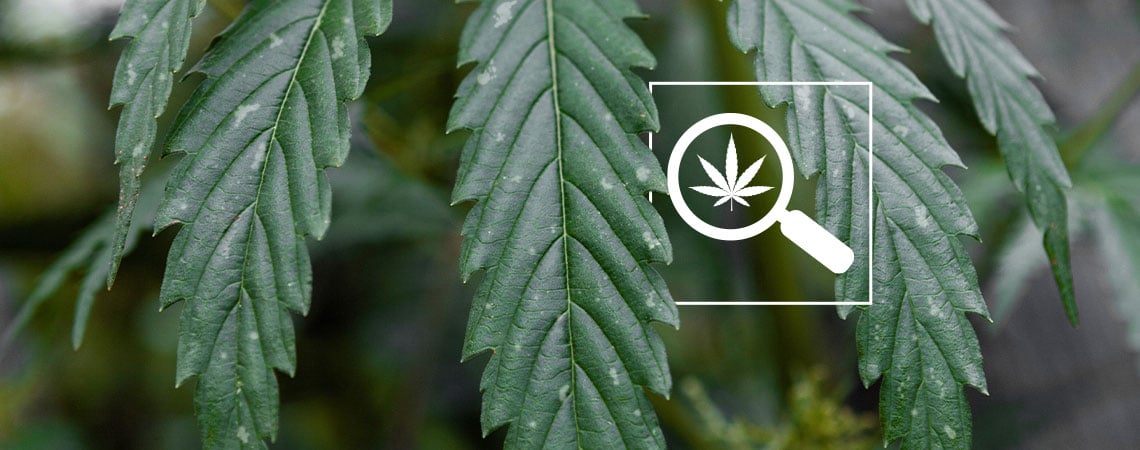
Noticed white spots on your cannabis leaves? Whether it's pests, mildew, or something else, this guide will help you diagnose the root of the problem and act accordingly. Learn about the causes of white spots on weed, treatment options, and how to prevent future outbreaks.
Seeing white spots on cannabis leaves can be concerning, both for rookies and veteran growers alike. Often appearing suddenly and spreading fast, some causes of white spots are only minor. Others, however, can seriously impact your plants’ health and potential yield.
In this guide, we'll help you quickly diagnose what causes white spots on weed leaves and act appropriately. From pests like spider mites to mould and mildew, we'll help you identify each issue correctly and provide you with trusted treatments. Let’s get started.
Common causes of white spots on cannabis

The first step after noticing white spots on cannabis leaves is to try to figure out what’s caused them. Several issues can trigger this symptom; some are relatively harmless, and others are more serious.
Below we’ll explore the most common culprits of white spots on weed and show you how to address them. However, make sure to check out our dedicated article on cannabis diseases for a comprehensive look at all the potential illnesses that can affect your cannabis plants.
Powdery mildew

Powdery mildew is one of the most frequent causes of white spots on cannabis, and it’s particularly common in indoor spaces with poor ventilation. This fungal infection looks like a fine, white dust coating the tops of leaves, often spreading rapidly in humid, stagnant growing spaces. Left untreated, it can inhibit photosynthesis, leading to stunted growth or even the death of plants.
Red flags to watch out for include:
- Soft, powdery white patches on the upper surfaces of leaves
- Curled or yellowing leaves
- Unhealthy new growth (powdery mildew tends to target young leaves first)
Pests (spider mites)
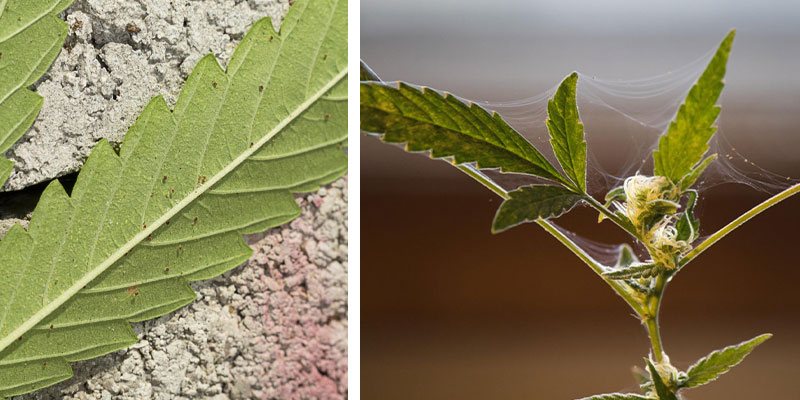
If the white spots on your weed plants look more like pinpricks than dust and appear on the underside of leaves, pests could be the problem. Spider mites, in particular, are microscopic insects that feed on plant cells, leaving behind pale dots and delicate webbing.
Some visual signs of spider mites to look out for include:
- Clusters of tiny white or yellow specks on leaves
- Fine, silky webbing between branches and stems
- Affected leaves with a faded or “dappled” appearance
Check out our article on spider mites for a complete guide to spotting, treating, and preventing these common cannabis pests.
Nutrient deficiencies
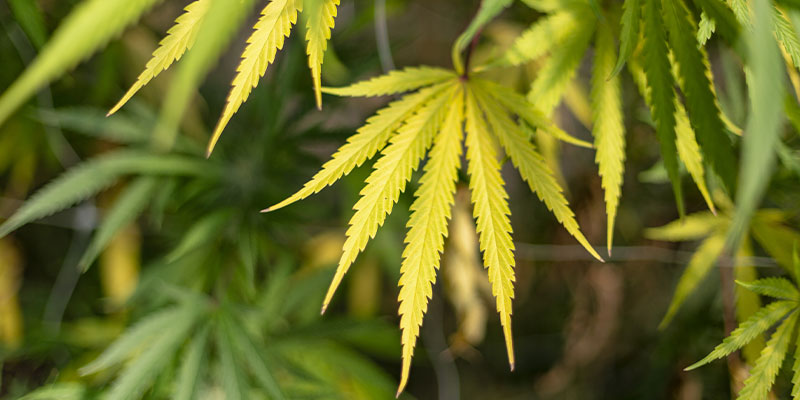
Not all white spots on a cannabis leaf are caused by pathogens or pests. Sometimes, white spots can be a sign that your plant isn't getting the nutrients it needs. Calcium or magnesium deficiencies, for example, can lead to patchy discolouration and spotting, usually accompanied by curled or burnt-looking leaves.
Here are some symptoms to look for:
- White or pale spots accompanied by yellowing or dark edges
- Spots that appear between leaf veins, not on top of them
- A progression of symptoms from lower to upper leaves as the deficiency worsens
While nutrient-related spots are less urgent than mildew or pests, they still impact your plants’ health and yield. Adjusting your feeding schedule or pH can often resolve the issue.
Environmental stress
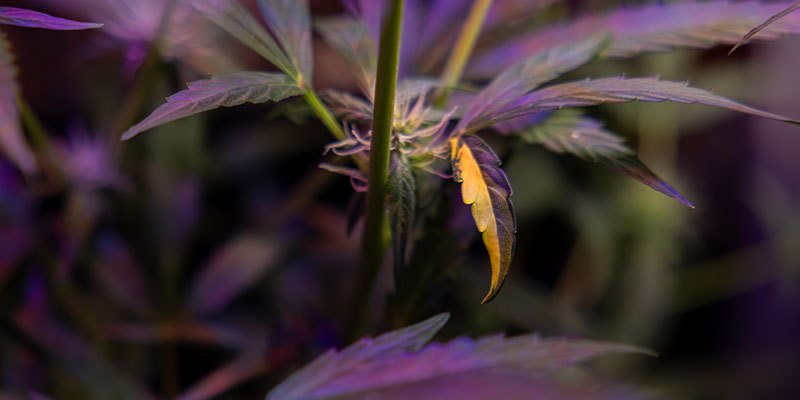
Sometimes, white spots on weed leaves result from environmental factors, particularly excessive light, heat, or low humidity. If your grow space lacks balance, your plants may develop bleached spots, dry edges, or even crispy patches due to stress from light, heat, a lack of moisture, or poor ventilation.
Key signs of white spotting related to the environment include:
- Pale, bleached areas on the leaves closest to your grow lights
- Leaves with a dry, brittle texture and curling edges
- No webbing, dust, or obvious signs of pests or pathogens
This kind of damage typically appears in the upper canopy, where leaves are most exposed to the elements. Unlike mildew or mites, the white spots caused by environmental issues often feel dry rather than soft or powdery. Adjusting the height and intensity of your grow light, as well as the conditions (temperature, humidity, and airflow) inside your space can help prevent further damage.
If white spots on cannabis leaves appear after changing your growing equipment, there’s a good chance that environmental issues are to blame. While these issues are often easier to fix than diseases or pest infestations, they still require some attention.
How to identify the cause of white cannabis spots

Diagnosing the exact cause of white spots on cannabis can feel overwhelming, especially to beginners. However, a few simple techniques can help simplify the process. Carefully examining where the spots appear, how they feel, and even how they smell can help you effectively target the cause and come up with the proper treatment.
Visual clues: location & texture
Start by carefully inspecting both the top and underside of your leaves. Here's a reminder of what to look for:
- Powdery mildew usually forms on the top sides of leaves and looks like soft, chalky dust.
- The damage from spider mites shows up as tiny white dots on the underside of leaves and may be accompanied by fine, white webbing.
- Nutrient deficiencies typically cause specific patterns of white dots, often between the veins of leaves or along their edges. They also cause colour fading.
- Environmental stress causes white blotches near the tops of plants, usually where light or heat exposure is highest.
Remember: check the texture of the spots by touching them. Generally speaking, if they feel powdery, it’s likely to be mildew. Sticky or webby spots, on the other hand, suggest that you may have pests on your hands.
Meanwhile, if the spots are dry and crispy, environmental stress is likely the main culprit. It's also worth noting that fungal infections like mildew often produce a musty or stale smell. If your plant smells normal but feels unusually dry, its white spots are likely caused by the environment.
Magnification tools
While touch, smell, and feel will tell you plenty about the condition of your plants, a handheld magnifier can provide even more clarity.
Tiny pests like spider mites are almost invisible to the naked eye, and early mildew often goes unnoticed until it spreads. A lens such as the Bud-O-Scope 60x Zoom, however, can help you spot these issues early.
What to do if you see white spots
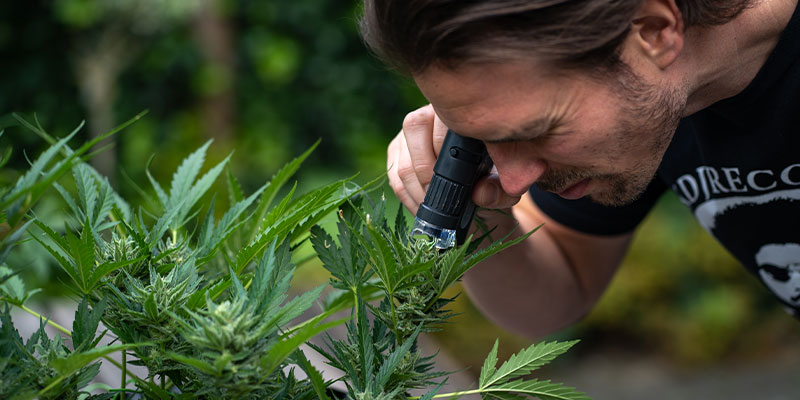
Noticing white spots on your cannabis leaves can be a worrying discovery, but acting quickly and methodically can help protect your crop. Whether the issue is pests, mould, or environmental stress, the following steps can help contain the problem and begin the recovery process.
Step 1: Isolate affected plants
The first priority is to prevent any potential spread to your healthy plants. If possible, move the affected plants (or plants) away from healthy ones, especially indoors. Fungal infections like powdery mildew and pests can spread quickly through contact or via shared ventilation systems.
When isolating your plants, remember:
- Avoid touching other plants after handling infected ones
- Clean your tools thoroughly before reusing them, as well as any surfaces where you handled your affected plants
- If you’re growing outdoors, increase the spacing between your plants (if possible)
Step 2: Diagnose the issue using magnification
Use a magnifying glass or a grower's scope to take a closer look at the affected plants. Identify whether the white spots are powdery, dotted, or dry, and look for signs like webbing, discolouration, or leaf deformities. This will help determine if you're dealing with mould, pests, or a nutrient/environmental imbalance.
Step 3: Apply immediate treatments
Once you've identified the issue, it's time to act fast:
- For pests or mildew: Use neem oil. It's a natural, effective solution that works against both fungal spores and soft-bodied insects like spider mites.
- For light/environmental issues: Raise your grow lights, adjust the temperatures, or increase/decrease humidity, depending on what's off.
- For nutrient problems: check your pH levels and adjust your feeding regimen, paying close attention to elements like calcium and magnesium.
Taking swift action is critical to preventing further spread and protecting your yield. And don't forget, seeing white spots on weed plants isn't always a disaster. In many cases, plants bounce back quickly with the right level of care.
Cleaning and prevention

After addressing the cause of the white spots on your plants’ leaves, it's essential to take steps that both clean up the affected plants and prevent the issue from returning.
Start by carefully removing leaves with heavy spotting, mould, or pest damage. This halts the spread of pathogens or insects, improves airflow, and allows the plant to redirect energy toward healthy growth. Be sure to dispose of these leaves away from your grow area; never compost infected plant material.
Improving your environment is key to long-term prevention. Consistent airflow will help deter pests and fungi, so ensure that you have fans circulating air evenly around and beneath your canopy. Aim for a 40–60% humidity range and avoid excessive heat buildup near your grow lights. Regularly cleaning filters, ducts, and fan blades can also reduce the risk of contamination.
Finally, adopt a routine inspection schedule to catch issues before they escalate. Examine both sides of your leaves, check for sticky residue or webbing, and monitor temperature and humidity levels daily. Keeping your tools clean and your environment stable minimises recurring issues and ensures your next harvest will be a healthy and abundant one.
Stay ahead of white spots on cannabis leaves

Dealing with white spots on cannabis leaves doesn't have to be stressful, as long as you know what to look for and act quickly. The key is early detection, so investing in a reliable magnifying tool can make a big difference; especially when it comes to spotting mites, mildew, or early signs of stress.
Additionally, choosing resistant cannabis strains when planning your next grow can help reduce the risk of recurring issues, especially in humid or pest-prone environments. By combining preventative care, regular inspections, and a proactive response plan, you can protect your plants from white spots and ensure they stay strong, vibrant, and ready to deliver a healthy yield.





 United States
United States











